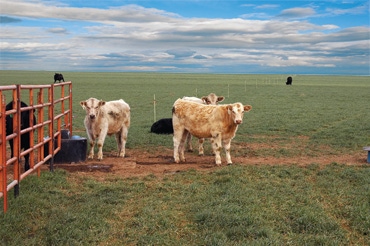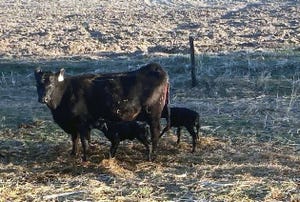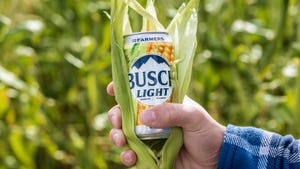Stockers Should Pencil Out This Fall And Winter
Stockers should pencil out this fall and winter, even if you don’t have grass or wheat.
October 1, 2011


With the continued demand for feeder cattle, stockers should pencil out a little profit this fall and winter – even if your grass is still parched and wheat pasture is wishful thinking, say Extension livestock specialists.
After the hottest, driest summer ever recorded in the Southern Plains, producers, stocker operators and feeders have seen a lot of herd liquidation, with lightweights sent to the feedyard and many cows sold for slaughter. However, the change of season hopefully will open new doors to profit opportunities, says Dan Childs, livestock marketing specialist at the Samuel Noble Foundation, Ardmore, OK.
“Creativity defines us in agriculture,” Childs says. “We’d like abundant supplies of grass. That’s a good scenario for some areas up north. But that’s not the hand we’ve been dealt in this region. Producers should sit down, look at their stocker budgets and calculate their value of gain with an altered stocker program they might have to put together.”
Childs says feeder-cattle futures prices indicate there could be sound profit potential, even if calf prices are high and corn, hay and other input costs aren’t where we want them. “With what the markets are offering ($130-140/cwt.), it looks like a profitable fall and winter for stockers,” he says.
The availability of wheat pasture will certainly vary across the country. August rains in northern Oklahoma brought some wide smiles to growers and cattlemen tired of the summer drought. Northwest Texas hasn’t been near as lucky. Ted McCollum, Texas AgriLife Extension beef cattle specialist in Amarillo, says that without adequate wheat pasture or grass, stocker guys should look at commodity feeds to develop growing programs for calves on short pasture or without pasture.
“I don’t think you can just go out and buy feed in a bag and make it work,” he says. “Different blends of commodity feeds, such as corn gluten feed pellets, soybean hull pellets and others, plus feed grains and some roughage, would provide a better chance for a good return.”
Crunch the numbers
One way to examine whether a stocker venture with or without pasture will work is to determine a ballpark breakeven price.
For example, if you buy a 450-lb. steer at $1.50/lb., or $150/cwt., that’s an initial cost of $675. If you take the animal to 700 lbs. and sell him for $138/cwt., that’s a sale price of $966.
That’s a gross profit of just under $291 for putting on the additional 250 lbs., or about $1.16/lb. of gain. To break even, you must hold your cost of gain to $1.16/lb. or below.
In late summer, McCollum figured the approximate preconditioning cost for a steer at $110/head, grazing cost on wheat at $146 (including 55¢/lb. of gain for 220 lbs.), and interest charges at 7.5%. That and the cost of the steer put the total cost at about $960. That’s $6 net profit at $138, or over $50/head profit, if the final selling price is $145/cwt.
That’s based on 45 days of preconditioning and a 120-day grazing period at an average daily gain of about 1.75 lbs./day.
“But no one knows what the price of feeder cattle will be in February or March when cattle come off wheat pasture or grass, or off a backgrounding system,” McCollum says. “It may be $130 or it may be $150.”
So it’s important to pin down your costs, and possibly use risk management tools to secure a floor price, he says.
Manage your winter costs
Childs says determining input charges to reach that final breakeven will likely vary for everyone. “When you don’t know about the price, you need to know your cost,” he says. “And, you can’t use your neighbor’s production cost.”
If winter calls for supplemental hay, overall production cost can be improved by simple things like using the right type of hay feeder, says David Lalman, Oklahoma State University (OSU) animal scientist. Lalman says hay waste can be greatly reduced by using feeders with a sheeted bottom.
For example, OSU tests using 5% prairie hay show that with a steel ring or poly pipe feeder with an open bottom, about 20% of the hay is wasted. That compares to about 13% with a steel ring with an open bottom, Lalman says.
However, a modified cone feeder with a sheeted bottom saw only a 5.3% waste and sometimes less. “You could need 20% less hay in the winter by using a better hay feeder,” he says. (See “What’s The Best Hay Feeder” in September BEEF)
Larry Redmon, Texas AgriLife Extension livestock specialist in College Station, says ranchers who sold off much of their cowherd might consider running stockers if they’re equipped to handle a backgrounding-type situation or have sufficient grass. But he encourages them to not rush cattle back on pastures when the first green pops up.
“Often, we get ahead of the grass with the cattle. People start putting on cattle when they see some green show up,” Redmon says. “But it takes a green leaf for that plant to photosynthesize. If that leaf is nicked off by a cow or calf, it will never see the root production we’d like to see.”
Pasture recovery is essential. “Wait until that grass is hay-harvest ready before you go back and restock,” he says.
McCollum says the overall cost of gain for stockers can easily shift if front-end preconditioning programs present problems. That can be from more health problems that require greater expense to get calves straightened out.
Since it may be more difficult to put together large numbers of stockers in light of tight calf supplies, he encourages operators to double-check the origin of calves and know all they can about the type of animal health or weaning programs under which they’ve been managed.
You May Also Like



